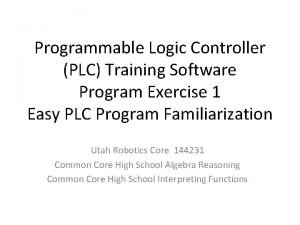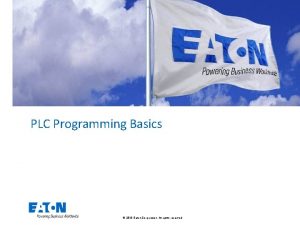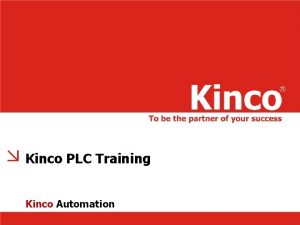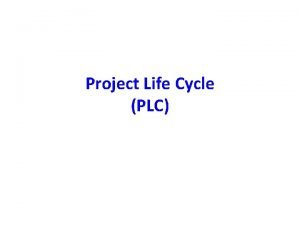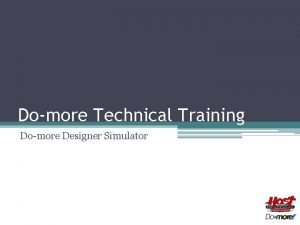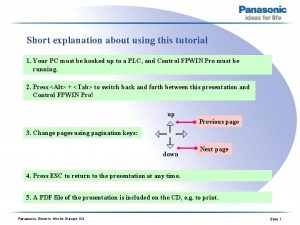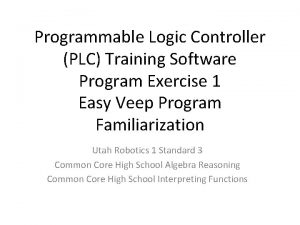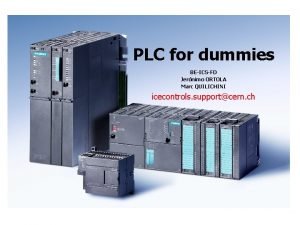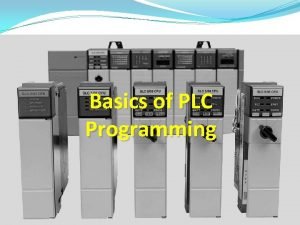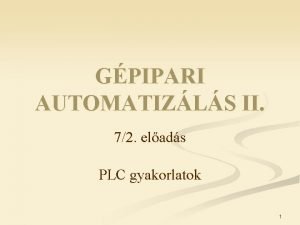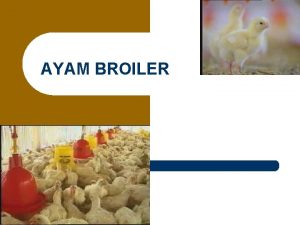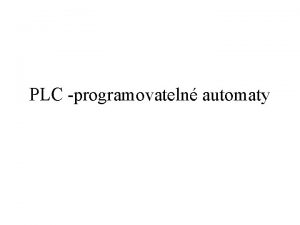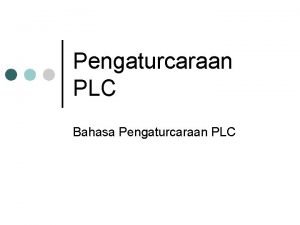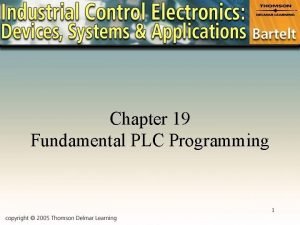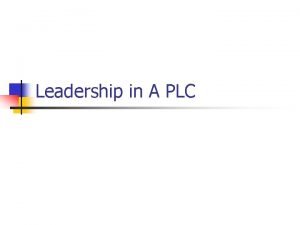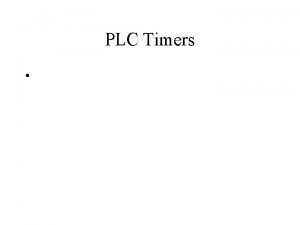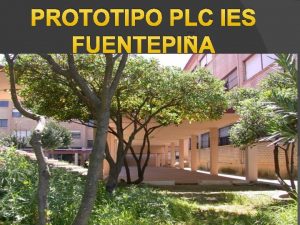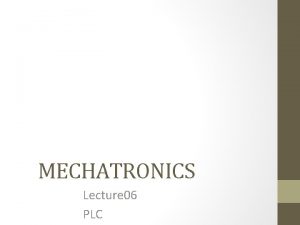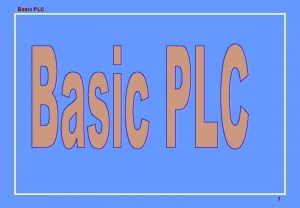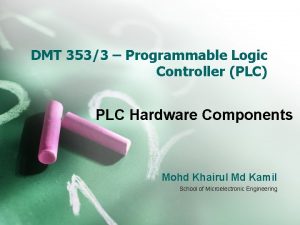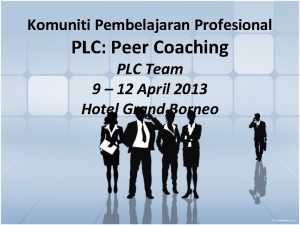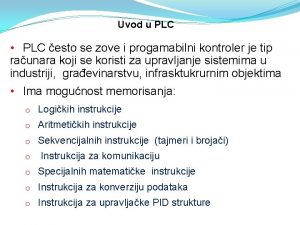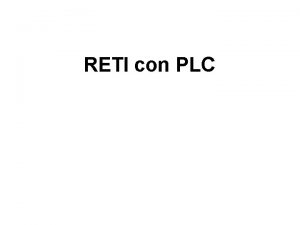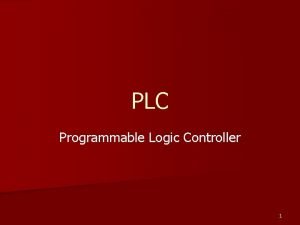Lesson 1 C PLC PROGRAMMING PLC PROGRAMMING All
























- Slides: 24

Lesson 1. C PLC PROGRAMMING

PLC PROGRAMMING All PLC must have user develop projects to operate. Projects can be entered: 1. A personal computer 2. SD card 3. Handheld terminal

PLC PROGRAMMING - IEC The International Electro-technical Commission, or IEC, has established a standard for programming of the field controllers, which has been adopted by most major controller manufacturers. This standard, IEC 61131 -3, has defined five languages in which the controller programming can be done.

PLC PROGRAMMING - IEC In Canada and the United States, the controllers are typically programmed in ‘Ladder Logic’, which closely resembles electrical wiring diagrams. In Europe, a machine level language, ‘Instruction List’ or ‘Machine Language’, is the preferred language for field controllers.

IEC ITU ISO IEC is one of three key organizations which establish such standards; the other two are the International Telecommunication Union (ITU) and the International Organization for Standardization (ISO). An example of an ISO standards that is used quite commonly is the 7 -layer model for communications; this standard has been adopted by most manufacturers for the interface driver communications. These three organizations work closely to ensure that any standard created works seamlessly across systems.

RSLogix 5000 software enables the user to develop Control. Logix projects using 4 different languages. It is possible to use all of the programming languages within a single project. 1. Sequential Function Chart (SFC) 2. Structured Text 3. Functional Block Diagram (FBD) 4. Ladder Logic

Sequential Function Charts Uses a flowchart-like language that uses steps and transitions to control a process or application. Effective method of programming an application that uses fixed sequence of inputs and outputs. Advantages: 1. Easier to read and organize 2. Reduced programming time to design and debug 3. Quick/easier Troubleshooting

Structured Text High level programming language that uses text statements to define the operation of the PLC. Often used in PLC applications that involve a lot of math or data conversion.

Function Block Diagram Graphical Programming language that encapsulates other programming language into blocks. The blocks are assembled and connected together so that it appears similar to an electronic circuit. Mostly used when applications involve a high degree of information flow between control components, such as process control.

Ladder Logic Resembles a ladder with rungs. Looks and operates very similar to hardwired relay systems.

Identifying Input & Output Signals Each process requires a PPC to monitor and control the operation within that section of the system. Identify al of the field inputs and outputs associated with each area. In developing a point list for a process area there are two general categories: 1. Equipment specific 2. General process signals Equipment specific are those connected to a unique device such as a motor, pump, or conveyor.

Identifying Input & Output Signals In a pump for example, these are organized by four basic signal types: Discrete Inputs: Pump run status Pump general fault or Alarm Suction valve open/c status Discrete Outputs: Pump run control Discharge Valve open/c status Analog Inputs: Suction Valve Position Feedback Pump VFD Positon Feedback Analog Outputs: Disch. Valve Position Feedback Pump VFD Positon Feedback

Tags Every program point in a program requires a unique name, called a tag or tag-name. Whether the point represents areal world field signal or an internal or virtual point, every point or signal must be uniquely identified with a tag name. Tags are text-based names given to PLC memory locations. They are used to store information about conditions both internal and external to PLC. Internal tags store information about the operating status of the PLC (i. e. operating properly or not) or the conditions of instructions within the PLC program.

Tags External tags represent the status of input or output devices connected to the PLC terminals. Some tags are automatically defined by the RSLogix 5000 software as input, output, or other functions as modules are added to the I/O configuration. Others are created by the user. Once a tag is defined, the name can be used in the PLC program. Using tag names enables the PLC program to operate, or make decisions based upon the internal and external conditions of the PLC.

Tags A each module is added or configured to a Control. Logix project, tags, are automatically created in the Controller. Tags folder for that module. The tag structure contains configuration, fault, and terminal status of the module. Module tags are named accordingly to their location, slot, and the data type. This permits the user to quickly find all information about an individual module.

Tag Name Components LOCAL: 1: l: Data. 0 The first word of the tag name, followed by a colon, indicates the general location of the module. Local for example, indicates that a module resides in the same chassis as the processor controlling it. If the module resides in a remote chassis, the name of the remote communications adapter is the location. For example, the remote adapter is named: Frame Line and input module in slot one is named Frame_Line: 1: 1: Data

Tag Name Components LOCAL: 1: l: Data. 0 The slot number further identifies the module’s location by identifying its location in the chassis. Slot numbers begin with 0 for the left-most slot and increase from left to right. Ex: (0, 1, 2, 3, …………. )

Tag Name Components LOCAL: 1: l: Data. 0 The type or third component of the tag, identifies the type of data contained in the tag.

Tag Name Components LOCAL: 1: l: Data. 0 The member name identifies the function of the data. There a number of member names, depending upon the type of module and type of data being sent. The two most common names are fault and data. Data indicates the tag contains I/O data exchanged with an input or output module.

Tag Name Components LOCAL: 1: l: Data. 0 The bit represents a specific terminal on the input or output module.

Function and Operation of Input/Output Diagrams

Identifying Inputs and Outputs Devices Because PLC sense and control real world devices, it is important to identify the device connected to each I/O terminal. PLC input/output (I/O) diagrams are used to show the specific physical connections between the I/O devices and PLC I/O terminals. An input device and an output device wired to a PLC is shown.

Identifying Inputs and Outputs Devices Because PLC sense and control real world devices, it is important to identify the device connected to each I/O terminal. PLC input/output (I/O) diagrams are used to show the specific physical connections between the I/O devices and PLC I/O terminals. An input device and an output device wired to a PLC is shown.

 Name all the rays
Name all the rays Plc training software
Plc training software Plc programming basics
Plc programming basics Kinco plc programming manual
Kinco plc programming manual Plc programming languages
Plc programming languages Plc phases
Plc phases Do-more designer plc programming simulator
Do-more designer plc programming simulator Panasonic plc programming examples
Panasonic plc programming examples Easyveep
Easyveep Marc quilichini
Marc quilichini Plc memory organization
Plc memory organization Plc programming
Plc programming Perbedaan linear programming dan integer programming
Perbedaan linear programming dan integer programming Greedy algorithm vs dynamic programming
Greedy algorithm vs dynamic programming What is in system programming
What is in system programming Integer programming vs linear programming
Integer programming vs linear programming Programing adalah
Programing adalah Help ever hurt never meaning in hindi
Help ever hurt never meaning in hindi Interventi sociali rivolti alla persona
Interventi sociali rivolti alla persona Crucified laid behind the stone
Crucified laid behind the stone I work all night i work all day
I work all night i work all day Basic communication operations in parallel computing
Basic communication operations in parallel computing Sistem all in all out
Sistem all in all out Arteria mediana cubiti
Arteria mediana cubiti Silent night holy night all is calm
Silent night holy night all is calm

